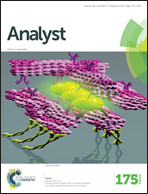A new approach for trace analysis of guanidine compounds in surface water with resorcinarene-based ion chromatography columns†
Abstract
Trace levels of pharmaceuticals have been detected in surface water and may pose a health risk to humans and other organisms. New chromatographic materials will help identify and quantify these contaminants. We introduce a new ion chromatographic (IC) material designed to separate cationic pharmaceuticals and report its ability to separate a group of guanidine compounds. Guanidine moieties are strongly basic and protonated under acid conditions, and therefore can potentially be separated on the newly designed stationary phase and detected by ion exchange chromatography. The new column packing material is based on glutamic acids bonded to resorcinarene moieties that in turn are bound to divinylbenzene macroporous resin. Detection limits in the range of 5–30 μg L−1 were achieved using integrated pulsed amperometric detection (IPAD) for guanidine (G), methylguanidine (MG), 1,1-dimethylbiguanide (DMG), agmatine (AGM), guanidinobenzoic acid (GBA) and cimetidine (CIM). Suppressed conductivity (CD) and UV-vis detection resulted in limits of detection similar to IPAD, in the range of 2–66 μg L−1, but were not able to detect all of the analytes. Three water sources, river, lake, and marsh, were analyzed and despite matrix effects, sensitivity for guanidine compounds was in the 100 μg L−1 range and apparent recoveries were 80–96%. The peak area precision was 0.01–2.89% for IPAD, CD and UV-vis detection.


 Please wait while we load your content...
Please wait while we load your content...